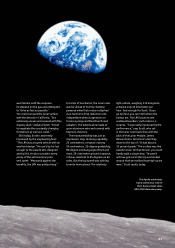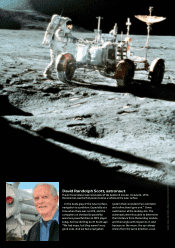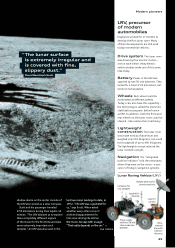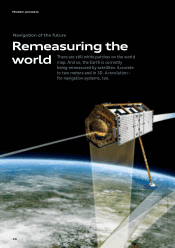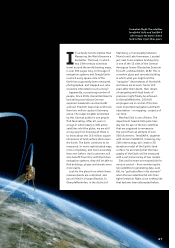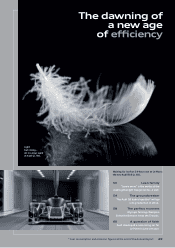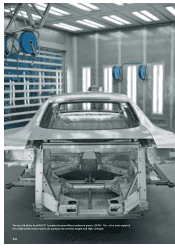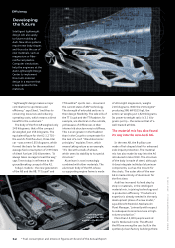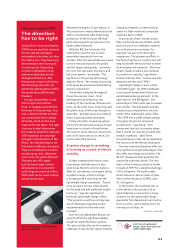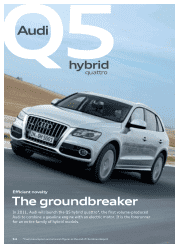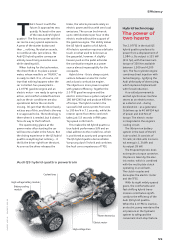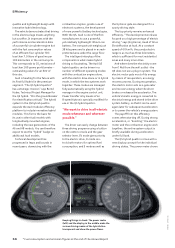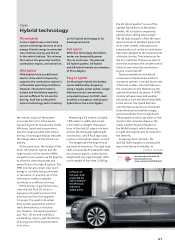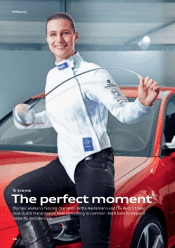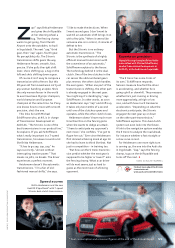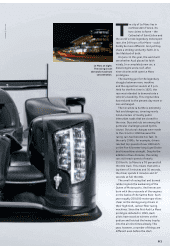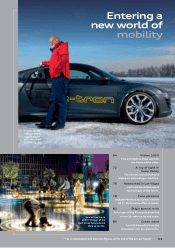Audi 2010 Annual Report Download - page 55
Download and view the complete annual report
Please find page 55 of the 2010 Audi annual report below. You can navigate through the pages in the report by either clicking on the pages listed below, or by using the keyword search tool below to find specific information within the annual report.
53
High-end material CFRP
The direction
has to be right
Carbon fi ber-reinforced plastics Carbon fi ber-reinforced plastics
(CFRP) are an excellent material (CFRP) are an excellent material
for not only the aerospace for not only the aerospace
and aviation industries, but also and aviation industries, but also
for making cars. They have long for making cars. They have long
demonstrated their strengths demonstrated their strengths
in motorsports. Depending in motorsports. Depending
on their confi guration, they on their confi guration, they
achieve outstanding tensile achieve outstanding tensile
strengths of 500 to 1,350 strengths of 500 to 1,350
Newtons per square millimeter, Newtons per square millimeter,
absorb energy very well, are absorb energy very well, are
extremely lightweight and off er extremely lightweight and off er
the greatest possible design the greatest possible design
freedom.freedom.
A single carbon fi ber is only A single carbon fi ber is only
fi ve to eight micrometers fi ve to eight micrometers
thick, or roughly one tenth the thick, or roughly one tenth the
thickness of a human hair. As a thickness of a human hair. As a
rule, 1,000 to 50,000 of them rule, 1,000 to 50,000 of them
are combined to form rovings are combined to form rovings
(strands), which are the base (strands), which are the base
material for the fabric. The layer material for the fabric. The layer
structure is what determines structure is what determines
the material properties: Because the material properties: Because
CFRP materials are only high-CFRP materials are only high-
strength in the direction of the strength in the direction of the
fi bers, the individual layers are fi bers, the individual layers are
laid down in diff erent directions. laid down in diff erent directions.
They are embedded in a matrix, They are embedded in a matrix,
usually epoxy resin. When the usually epoxy resin. When the
resin cures, the part is fi nished. resin cures, the part is fi nished.
The parts are still largely The parts are still largely
built by hand today. Further built by hand today. Further
developments in production developments in production
technology are required before technology are required before
CFRP parts can be used in large-CFRP parts can be used in large-
volume production.volume production.
Whereas the degree of automation in
A8 production is nearly identical to that
with a conventional steel sheet body,
production of the exclusive R8 high-
performance sports car has more of a
handcrafted character.
With the R8, the front end, the
central fl oor and the rear end are
assembled separately from one
another. After the assemblies are joined
to form the substructure, the pillars
and the large metal panels – primarily
the roof, the side walls, the doors and
the cover panels – are added. “The
key factor is the joining technology,”
explains Elend. “We mostly use joining
techniques developed and patented by
Audi for production.”
The perfect interplay throughout
the entire process chain – from
development and planning, the
building of the machines, fi xtures and
tools, to the press shop, body shop and
the paint shop, all the way through to
assembly – all takes place according to
Audi’s exacting quality standards.
A fully automatic measuring system
checks the dimensional accuracy of each
body down to a tenth of a millimeter.
The scanner works without contact and
uses its 95 laser sensors to check 220
points within fi ve seconds.
Further extending the lead in struc-
tural design and fabrication is also
what drives Elend to new innovations.
After all, carmaking is once again facing
a system change, and this change
is bringing with it new tasks for the
lightweight design specialists. “Future
drive concepts set new requirements
for the body and add additional weight
to the car,” says the new Head of
the Audi Lightweight Design Center.
“This presents us with an entirely new
set of challenges regarding proper
implementation for the materials
involved.”
Audi will use lightweight design con-
cepts to off set the signifi cant added
weight for electrifi ed drive systems.
This also includes the use of innovative
materials. It was for this reason that the
Company invested in a new technical
center for fi ber-reinforced composite
materials back in 2009.
In particular, these include carbon
fi ber-reinforced plastics (CFRP), which
Audi will use in an intelligent material
mix with aluminum and steel, for
example, but also with ultra-light
magnesium. The pioneering eff orts in
the fi eld of aluminum construction will
help to transfer the know-how to other
technologies and materials. “We know
what it means to take a new material
to production maturity,” says Board
Member Michael Dick, “and we will also
demonstrate this with CFRPs.”
Lightweight design is even visible
in the R8 Coupé*. Its CFRP sideblades
in structured honeycomb look are an
unmistakable design element. In the
open version, the R8 Spyder*, the
percentage of CFRP parts was increased
even further. The side panels and the
complex top compartment cover are
made of the lightweight carbon fi ber.
“The CFRP hatch yields weight savings
of roughly 20 percent compared
to aluminum,” says Elend. “This
component has such a complex shape
that it would not even be possible with
metallic materials,” adds Timm,
his predecessor under whose leadership
the structure of the R8 was developed.
The new materials therefore off er not
only signifi cant weight advantages, they
also off er new design possibilities. The
R8 GT* shows just what potential the
composite materials harbor. The rear
hatch of the limited production model
is made of CFRP for a weight advantage
of 6.6 kilograms. The bucket seats,
which feature a chassis made of glass
fi ber-reinforced plastic (GFRP), save
31.5 kilograms.
In the future, the challenge will lie
in the ability to also produce ultra-
light materials economically in large
volumes. So the lightweight design
specialists from Neckarsulm will not be
short on work – and certainly won’t be
running out of ideas.
THOMAS AMMANN
Visible high-tech: CFRP sideblade
of the Audi R8 GT.
A system change in carmaking
is looming as a result of electric
mobility.
Visit the Audi Lightweight
Design Center: www.audi.com/
ar2010/lightweight


